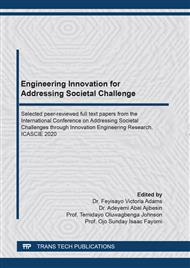[1]
Srinivasan KM. Rotodynamic Pumps (Centrifugal and Axial). New Delhi: 2008. doi:ISBN (13) : 978-81-224-2976-3.
Google Scholar
[2]
Cunha I da, Strack T, Stricker S. PUMP SYSTEMS: Energy Efficiency Reference Guide. CEATI International Inc; (2008).
Google Scholar
[3]
Scheaua F. Aspects Regarding Axial Propeller Pumps Principle. Proc. 2016 Int. Conf. Hydraul. Pneum. - HERVEX, 2016, p.36–40. doi:ISSN 1454 - 8003.
Google Scholar
[4]
Karassik IJ, Messina JP, Cooper P, Heald CC. Pump Handbook (Third edition). McGraw-Hill; 2001. doi:ISBN 0-07-034032-3.
Google Scholar
[5]
Ramasamy N, Ganesan K. An Investigation On Design And Performance Optimization Of Pump Impeller. Int J Eng Dev Res 2016;4:74–7. doi:ISSN: 2321-9939.
Google Scholar
[6]
Garibotti E. Centrifugal Pump Handbook (first edition). Termomeccanica Pompe; 2003. doi:ISBN-8890099607.
Google Scholar
[7]
Zhang D, Zhang G, Shi W, Li T. Performance prediction and experimental verification of axial flow pump based on CFD. Appl Mech Mater 2012;152–154:1566–71.
DOI: 10.4028/www.scientific.net/amm.152-154.1566
Google Scholar
[8]
Park HS, Miao FQ. Multi-objective optimization by using modified PSO algorithm for axial flow pump impeller. Adv. Intell. Syst. Comput., vol. 319, 2015, p.223–37.
Google Scholar
[9]
Wu Q, Wang X, Shen Q. Research on dynamic modeling and simulation of axial- flow pumping system based on RBF neural network. Neurocomputing 2016;186:200–6.
DOI: 10.1016/j.neucom.2015.12.064
Google Scholar
[10]
Badr HM, Ahmed WH. PUMPING MACHINERY THEORY AND PRACTICE. John Wiley & Sons; 2015. doi:docID=1889218.
Google Scholar
[11]
Turton RK. Rotodynamic pump design. Cambridge University Press; 1994. doi:https://doi.org/10.1017/CBO9780511529573.
Google Scholar
[12]
Kan K, Zheng Y, Chen Y, Xie Z, Yang G, Yang C. Numerical study on the internal flow characteristics of an axial-flow pump under stall conditions. J Mech Sci Technol 2018;32:4683–95.
DOI: 10.1007/s12206-018-0916-z
Google Scholar
[13]
Yan P, Chen T, Wu DZ, Wang LQ. Multi-point optimization on the diffuser of an axial flow pump. IOP Conf. Ser. Mater. Sci. Eng., vol. 52, 2013, p.1–6.
DOI: 10.1088/1757-899x/52/2/022011
Google Scholar
[14]
Kulkarni SJ. Factors Affecting Pump Performance- An Insight into Research and Investigation. Int J Res Rev 2017;4:39–42. doi:E-ISSN: 2349-9788; P-ISSN: 2454-2237.
Google Scholar
[15]
Luo X, Ji B, Tsujimoto Y. A review of cavitation in hydraulic machinery. J Hydrodyn 2016;28:335–58.
Google Scholar
[16]
Feng W, Cheng Q, Guo Z, Qian Z. Simulation of cavitation performance of an axial flow pump with inlet guide vanes. Adv Mech Eng 2016;8:1–8.
DOI: 10.1177/1687814016651583
Google Scholar
[17]
Kernan D. Pumps 101 : Operation , Maintenance and Monitoring Basics. ITT 2009:1–10. doi:https://www.gouldspumps.com/ittgp/medialibrary/goulds/website/Literature/White%20Papers/ITT_white_paper_Pumps_101_Operation_Maintenance_and_Monitoring_Basics.pdf?ext=.pdf.
Google Scholar
[18]
Taghi M, Tabar S, Poursharifi Z. An Experimental Study of Tip Vortex Cavitation Inception in an Axial Flow Pump. Int J Mech Mechatronics Eng 2011;5:86–9. doi:ISNI:0000000091950263.
Google Scholar
[19]
Optimizing pump reliability and performance. Sulzer Ltd 2020:1. https://www.sulzer.com/en/campaign/optimizing-pump-reliability-and-performance.
Google Scholar
[20]
Park H, Miao F, Nguyen T. Impeller design for an axial-flow pump based on multi-objective optimization. Indian J Eng Mater Sci 2018;25:183–90.
Google Scholar
[21]
Miao F, Park H, Kim C, Ahn S. Swarm intelligence based on modified PSO algorithm for the optimization of axial-flow pump impeller. J Mech Sci Technol 2015;29:4867–76.
DOI: 10.1007/s12206-015-1034-9
Google Scholar
[22]
Shi LJ, Tang FP, Liu C, Xie RS, Zhang WP. Optimal design of multi-conditions for axial flow pump. IOP Conf. Ser. Earth Environ. Sci., vol. 49, 2016, p.0–10.
DOI: 10.1088/1755-1315/49/6/062028
Google Scholar
[23]
Jung IS, Jung WH, Baek SH, Kang S. Shape Optimization of Impeller Blades for a Bidirectional Axial Flow Pump using Polynomial Surrogate Model. Int J Mech Mechatronics Eng 2012;6:1097–103. doi:ISNI:0000000091950263.
Google Scholar
[24]
Qian Z, Wang Y, Huai W, Lee Y. Numerical simulation of water flow in an axial flow pump with adjustable guide vanes. J Mech Sci Technol 2010;24:971–6.
DOI: 10.1007/s12206-010-0212-z
Google Scholar
[25]
Yang F, Zhao H, Liu C. Improvement of the Efficiency of the Axial-Flow Pump at Part Loads due to Installing Outlet Guide Vanes Improvement of the Efficiency of the Axial-Flow Pump at Part Loads due to Installing Outlet Guide Vanes Mechanism. Math Probl Eng 2016:1–10. doi:http://dx.doi.org/10.1155/2016/6375314.
DOI: 10.1155/2016/6375314
Google Scholar
[26]
Yang F, Liu C. Numerical and Experimental Investigation of Slanted Axia-Flow Pumping System. J Eng Sci Technol 2013;6:62–8. doi:ISSN: 1791-2377.
Google Scholar
[27]
Zhang R, Chen HX. Numerical analysis of cavitation within slanted axial-flow pump. J Hydrodyn 2013;25:663–72.
DOI: 10.1016/s1001-6058(13)60411-4
Google Scholar


